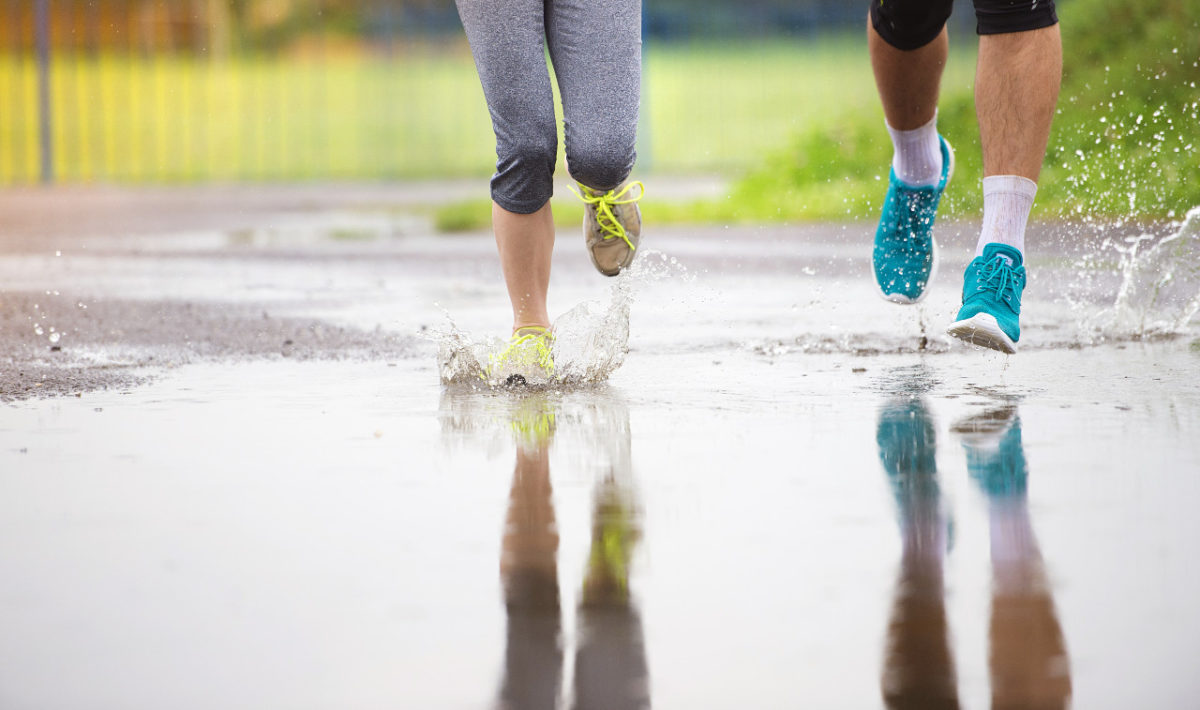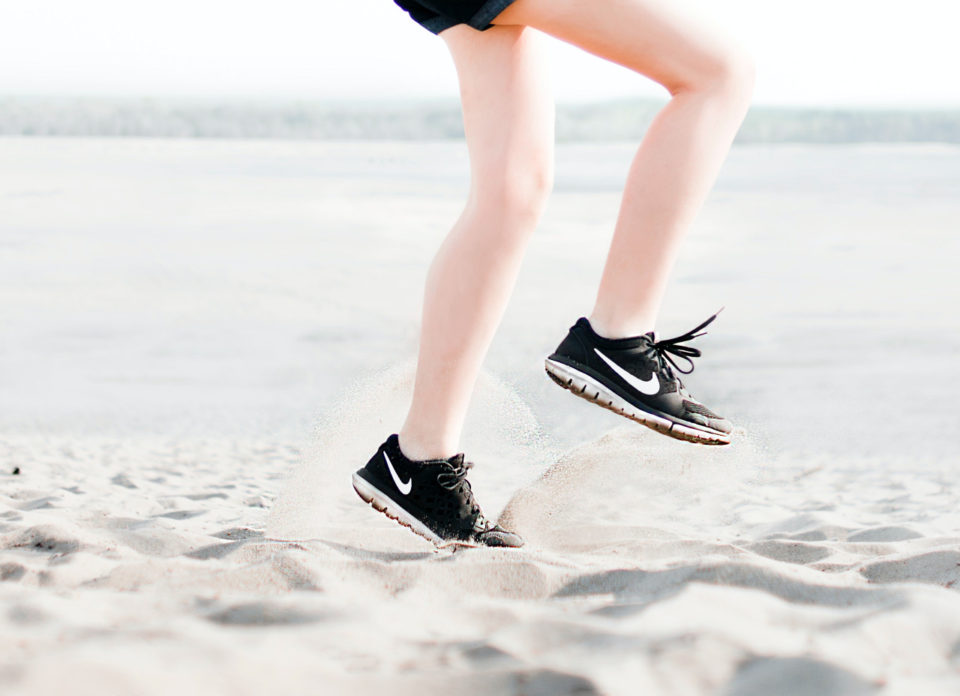
Although this summer we might be enjoying great running conditions, we are also frequently faced with extreme conditions. Conditions that many runners will still brave, or even look for to vary their training or to target other muscle groups. That might be running on sand or other unusual surfaces, or in extreme weather conditions like heat, cold or rain. If you’re someone who runs in all weathers and conditions, we’ve put together a few tips that will help you however and whenever you run.
Running in hot weather
As it’s July, let’s start with running in hot weather. This is the time of year when you’re often faced with the problem or question of whether to go running in hot weather. In general, it depends on how well you tolerate heat. There are different types of runners. Some really get into top gear in very warm temperatures, others avoid these conditions and perform better at lower temperatures. If in the past you weren’t someone who enjoyed running in hot weather, you can still change. Your body can get used to running in high temperatures. Just 10 days of training in high temperatures can be enough to increase your tolerance of heat. Your body adjusts to the higher temperatures, for example, by starting to produce sweat sooner and ensuring that it contains fewer electrolytes so that it evaporates quicker on your skin. Your cardiovascular system can also adapt to higher temperatures.
Take note of the following tips if you’re planning to run in hot weather:
- You should reduce the running distance and intensity of your training in hot weather. Experts recommend a reduction of around 30 to 50 percent.
- Avoid the midday sun! Reschedule your training sessions for the mornings and evenings, the temperatures at that time of day are generally still bearable.
- Use routes with shade. For example, it’s cooler in woods than along a street.
- Cool yourself down beforehand with a cold shower. This will slightly reduce your body core temperature before an arduous training session.
- It’s all about wearing the right clothes. Light running clothes are a must in high temperatures.
- Headgear can protect your head from the sun, but you lose most heat from your head, so it’s better (naturally so long as you are not exposed to constant sunlight when running) to do without a hat. Otherwise, you’ll only sweat more needlessly.
- Don’t forget to drink in hot temperatures! We’ve already put together a blog on everything you need to know about “Drinking properly for sport”.

Running in rain
There are times when the rain stops us all from going on a planned training run – but you can always brave the wet weather. We know the best way to approach running in the rain, and have put together a few tips for wet weather runners.
We all know the saying “There is no such thing as bad weather, only bad clothes”. And that is particularly the case when running in the rain! You need to think about the material of both your running shoes and your running clothes. Your running shoes need to give you enough grip to stay upright on paths that are slick in the rain. Pay particular attention to the tread. The bigger the tread on your running shoes, the better the grip and foothold. The upper will also have an impact on how quickly your feet get wet. Unfortunately, a lot of breathable running shoes that are great for warm temperatures are also very permeable to water. However, waterproof shoes make feet extremely sweaty, which is not ideal either! So, if you don’t want to buy two different pairs of running shoes, you need to choose a running shoe with a rather thickly knit upper that is water-repellent, but not completely waterproof.
You should also think about the socks you wear when running in the rain. In normal conditions, the friction can give you blisters, but this is even more likely if your socks are wet. The same applies to chafing between your thighs or even your upper arms. Prevention is far better than cure, particularly in the rain, so we suggest you use our pjuractive 2SKIN.
When it comes to running clothes, it’s best to avoid cotton. And wearing as many clothes as possible to keep your body dry is not a great idea either. Ideally, wear functional clothes and a water-repellent running jacket. This will protect you from getting wet for as long as possible. The rule is: the fewer clothes the better. Because the more clothes you wear, the more you have to carry later when the clothes become saturated with water.
Here are a couple more tips for running in the rain:
- When it’s raining, always run on streets you know, where you’ll be able to avoid slipping or stumbling hazards.
- Running fast in the rain increases your risk of injuries. So, it’s best to go for slow runs and adapt your training to the weather.
- After going running in the rain, you should immediately have a shower. Otherwise, your body might cool down too quickly.
If you’re still debating whether to run in the rain, we recommend you go for it! You’ll not only strengthen your immune system and be fully prepared for different conditions in races – you might even finally get your favourite running route all to yourself ?
Running on sand
It’s the holidays and if you want to keep running on holiday, then you might (depending on your destination) have the chance to run on the beach. Running on sand is very different to running on tarmac or woodland paths, which means it’s a completely different way of using your muscles. And jogging on the beach has other, unique benefits for you and your body:
- The sandy surface means you use your body, or more specifically, your feet and calf muscles in a very different way, and considerably more than on other surfaces. Sand is soft, so you need significantly more power to keep up the pace. Your body will react to this with a clean and dynamic running technique.
- You will quickly notice that running on sand is more tiring, but also far more effective. Because the surface is uneven, all of the supporting muscles in your torso have to work particularly hard to compensate.
- By working your muscles harder when running on sand, your body burns considerably more calories, not just during training, but also afterwards through the afterburn effects.

Although the benefits sound tempting, there are still a few things to bear in mind if you’re planning to run on the beach:
- Your body will tire quicker because of the greater effort required. So, plan shorter runs. They will have the same effect as longer runs on other surfaces ?
- If you’ve had less practice running on sand, you need to be a bit careful. It is very strenuous for your muscles, so it’s easy to overdo it or get an injury. Take it slowly and start off with short training runs.
- As beaches generally slope down towards the sea, your back can be put under considerable strain. Either try to find a stretch of beach that is as flat as possible to run on, or regularly change the direction you run in to avoid straining one side.
- Protect yourself from the sun’s rays while running on the beach and make sure you put on enough sun cream. It’s also even more important to drink enough when you’re doing a strenuous workout on the beach.
Running in cold weather
In a couple of months it will be cold again outside, and while some runners use this time to recover, others embrace the cold and go for a run anyway. And this is a good thing, as while we tend to spend a lot of time outside in summer, in winter we stay in and switch on the heating. Going for a run in the fresh air during the colder months is not only a great way to strengthen our immune system; it also trains our breathing apparatus and cardiovascular system. Plenty of reasons to get out in the cold! But there are a few things to bear in mind:
- Plan more time for your warm-up. It’s best if you warm up inside, before going out into the fresh air. This ensures your musculoskeletal system is already at the right temperature.
- Make sure you don’t inhale the cold air directly. Breathe through your nose or use a mask to prevent the cold air from irritating your airways.
- In cold temperatures it is also advisable to limit your training sessions to 20 to 40 minutes.
- Cold is not a problem, but there is such a thing as too cold! Avoid training outside if temperatures drop below -15° Celsius.
- Wear layers of functional clothing. In this post, we advise you on the best clothes to wear if you’re staying active in winter.
- Warm yourself up again at home straight after training with a warm shower or bath.
You can go running in a range of conditions. And our tips will help you get the most out of your training in the future. Safe running!
Image sources: shutterstock_225976438, shutterstock_1017406066, pexels-dominika-roseclay-1166868